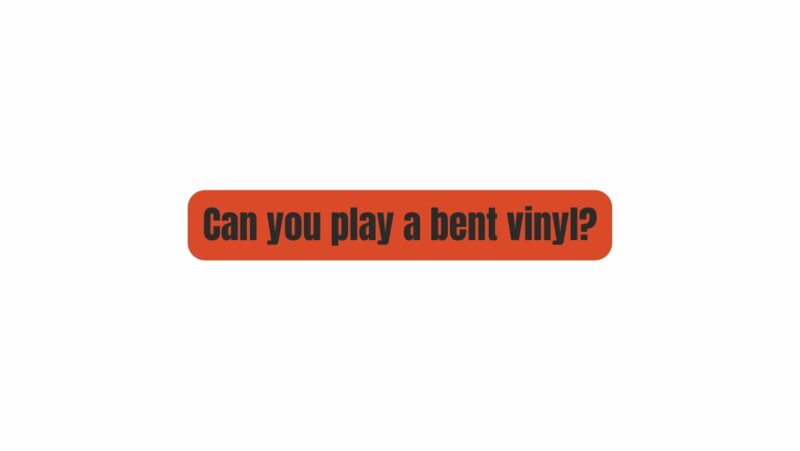Vinyl records, revered for their analog warmth and tactile charm, have experienced a resurgence in popularity among audiophiles and music enthusiasts. However, one of the challenges that collectors and vinyl enthusiasts occasionally encounter is dealing with bent or warped records. A common question that arises is whether it’s possible to play a bent vinyl record without causing harm to the record itself or compromising sound quality. In this article, we’ll explore the world of bent vinyl records, the reasons behind their deformation, and the implications of playing them.
Understanding Vinyl Warping and Bending
Before delving into whether bent vinyl records can be played, it’s important to understand the various types of warping and bending that can affect vinyl records:
- Warping:
- Warped records typically exhibit a noticeable curvature, causing the entire surface to deviate from its intended flat form. Common types of warping include bowl-shaped warps, edge warps, and dish-shaped warps.
- Moderate warping may result from exposure to heat, uneven storage, or external pressure, while severe warping can occur due to excessive heat or weight.
- Bending:
- Bent records, on the other hand, exhibit localized or focused deformation, often involving a section of the vinyl that is bent or creased. This type of damage can occur during shipping, mishandling, or storage.
- Bending typically affects a specific area of the record, such as a groove, rather than the entire surface.
The Challenge of Playing Bent Vinyl Records
Playing a bent vinyl record poses several challenges, and the implications can be both audible and physical:
Audible Implications:
- Sound Quality: The most significant concern when playing a bent record is the potential impact on sound quality. A bent or creased groove can cause tracking issues for the stylus, resulting in audible pops, skips, and distortions during playback.
- Stylus and Record Wear: Playing a bent record places additional stress on the stylus and the groove. This can accelerate stylus wear and potentially damage both the stylus and the record’s grooves.
- Tracking Force: To compensate for the bend or crease, the stylus may exert uneven pressure on the groove, which can lead to tracking force imbalances and further affect sound quality.
Physical Implications:
- Stylus Damage: The stylus (needle) is particularly vulnerable when playing a bent record. Excessive stress on the stylus can result in damage, requiring a replacement.
- Further Deformation: Playing a bent record can exacerbate the existing deformation, potentially making it more difficult to play in the future.
When Not to Play Bent Records:
- Severe Bending: Records with severe bending or creasing, where the deformation is highly noticeable, are best avoided for playback. Attempting to play severely bent records can lead to significant stylus and groove damage.
- Valuable or Rare Records: Valuable or rare records should be treated with utmost care. If a valuable record is bent or creased, consult a professional audio technician or restoration expert before attempting to play it.
When It Might Be Possible to Play Bent Records:
- Minor Bending: Records with minor, barely noticeable bends may be played with caution. However, it’s important to monitor the playback closely for any signs of tracking issues or audible imperfections.
- Experimentation: In some cases, it may be worthwhile to experiment with tracking force adjustments, stylus types, and turntable settings to mitigate playback issues. This can be especially useful if the record holds sentimental value.
Preventing Vinyl Record Bending and Warping
Preventing vinyl record bending and warping is essential for preserving your collection. Here are some tips to help minimize the risk:
- Proper Storage: Store your records vertically, like books on a shelf, to prevent warping. Avoid stacking heavy objects on top of records.
- Optimal Environment: Maintain a stable, cool, and dry environment for your records. Avoid exposing them to direct sunlight or extreme temperature fluctuations.
- Use Outer Sleeves: Protect your records with polyethylene or polypropylene outer sleeves to shield them from dust, dirt, and contaminants.
- Gentle Handling: Handle records with care, holding them by the edges to avoid contamination and potential bending.
- Avoid Over-Tightening: When using inner sleeves, avoid over-tightening them, as this can cause the record to warp over time.
- Regular Inspection: Periodically inspect your collection for signs of warping or bending. Early detection can help prevent further damage.
Conclusion: Navigating the World of Bent Vinyl
Playing a bent vinyl record can be a challenging endeavor, and it’s important to approach it with caution and consideration. While it might be possible to play a record with minor bending, the implications for sound quality and record and stylus wear should not be underestimated.
Ultimately, the goal is to preserve the cherished vinyl experience while safeguarding your collection’s integrity. In cases of severe bending or valuable records, consulting a professional is advisable to avoid irreparable damage.
Remember that vinyl records, whether bent or flat, are conduits of music and memories. Each one tells a story, and the journey of caring for and playing them is as much a part of the experience as the music itself.


